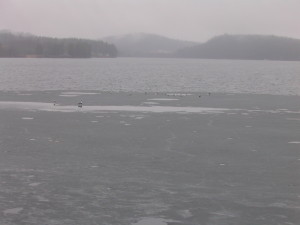by Susan Trask, 6/13/2010
The first sign is usually a darkening of the thick dirty gray surface. Then you start to notice some small openings along the shoreline, and perhaps some wet-looking patches scattered here and there. Sometimes it will freeze back solid, but you know that the end of the long, still winter of ice on the lake is not far away.
Ice out April 9th, 2004. This patch of ice blew into a cove on April 14th that year.
It’s never the same twice. Some years, you will awake to a suddenly-open expanse of water stretching nearly all the way across. Once you have large open patches, a good wind on a sunny day can do away with most of the ice in short order. Other years that darkening effect continues, until the ice gradually disappears. (No, it doesn’t actually sink, although many will insist that it does.) My favorite years are those where the deteriorating ice becomes honey-combed, with long shards that tinkle together when the wind blows like eerie, magical wind chimes.
It seems that each lake or pond has its own tradition of how one actually defines “ice-out.” In an earlier less eco-conscious time, some folks would drive a car out onto a certain spot on the lake and record when it fell through. Many lake watchers define ice-out it less dramatically, say by when one can navigate from Point A to Point B, or merely when the ice is “virtually gone” as the Auburn Water District does. On Taylor Pond, a number of lakeside enthusiasts kept an ice-out pool for many years, whose winner was determined when Jan Marston and Pat Garcia certified that they couldn’t see any ice in any cove. However the various locations define it, nearly everyone in the state noted their earliest-ever ice-out in 2010. This year Taylor Pond beat its previous record, set in 1981, by eight days, clocking out on March 20.
Those of us lucky enough to witness the ice-out phenomenon yearly count it as a real turning point, a sure sign that spring is coming soon, that muddy yards will be dry enough to pick up winter’s debris, that we can begin to look for crocuses peeking through the remaining snow. The earlier the better, right? The docks and boats in sooner, more days of boating, fishing and swimming. What’s not to like?
Here’s where a few facts of lake biology come in. Once the ice is gone, the sun warms the surface of the water and provides nutrients for algae and other plants to begin growing. The lower part of the lake remains relatively cold. Obviously, the more sunny days we have, that upper warmed layer will be larger and the bottom colder layer will be smaller. Since the biological activity of the growing plants depletes oxygen, less of it will be available in the colder layers for fish. According to director of VLMP (Volunteer Lake Monitoring Program) Scott Williams, that warmer upper layer also creates a “more biologically productive environment for algae growth” and the possibility of increased proliferation of invasive plants. (So far, we don’t have any of these on Taylor Pond!)
Some will be quick to conclude that the state-wide recording breaking of ice-out dates is because of global warming. Others will point out that one cannot pin down the data of a single year to a single cause. Whatever the cause, we can certainly enjoy the benefits of our early spring. While we do, however, let’s also recommit to doing all we can to prevent our own actions from further jeopardizing our beautiful resource. Remember, the simple things really count: Keep a good buffer strip, refrain from using phosphorous-laden fertilizers, and control your boat wakes. As we take full advantage of this beautiful season this year, let’s also be sure we do all we can to enjoy many spectacular ice-outs in the future!
For the record: Here are Taylor Pond’s ice-out dates back through 1969, courtesy of Peg Wallingford and Jan Marston:
| 1969 | Apr 21 | 1980 | Apr 11 | 1991 | Apr 8 | 2002 | Apr 8 | |||
| 1970 | Apr 27 | 1981 | Mar 26 | 1992 | Apr 15 | 2003 | Apr 13 | |||
| 1971 | May 1 | 1982 | Apr 25 | 1993 | Apr 21 | 2004 | Apr 9 | |||
| 1972 | Apr 30 | 1983 | Apr 5 | 1994 | Apr 19 | 2005 | Apr 12 | |||
| 1973 | Apr 17 | 1984 | Apr 18 | 1995 | Apr 13 | 2006 | Apr 2 | |||
| 1974 | Mar 16 | 1985 | Apr 14 | 1996 | Apr ? | 2007 | Apr 12 | |||
| 1975 | Apr 25 | 1986 | Apr 12 | 1997 | Apr 23 | 2008 | Apr 21 | |||
| 1976 | Apr 14 | 1987 | Apr 11 | 1998 | Apr 8 | 2009 | Apr 12 | |||
| 1977 | Apr 14 | 1988 | Apr 10 |
